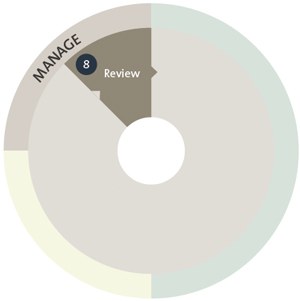Part 10: Evaluating and reviewing the procurement
 10.1
10.1
The final stage in the procurement life cycle is assessing whether the intended benefits from a procurement have been realised and whether any lessons can be learnt from the process.
Realising benefits
10.2
Benefits management starts earlier in the life cycle when the public organisation defines what procurement and business outcomes are needed. Benefits should be aligned to a public organisation's strategic goals. The delivery of the intended benefits needs effective project management and active monitoring of progress and the benefits to be realised.18
10.3
At times, we have found in our work that public organisations do not understand the importance of managing benefits or do not have effective arrangements to assess them.
10.4
Benefits are the reason procurement is carried out. To successfully deliver any procurement, it is essential that the project managers and governors focus on realising the benefits of the procurement from the start of the procurement process. They should:
- understand clearly what the intended benefits are and how they can be achieved;
- be agile enough to ensure that benefits can be fully realised and enhanced; and
- be able to adapt the project, if required, to realise the intended benefits.
10.5
Showing the benefits that resulted from a project is also a way to show accountability. Reporting on what was achieved from a procurement is one way of being transparent about the procurement process and accountable for how the money was spent.
Learning lessons
10.6
It is important that, by the end of a procurement, public organisations assess what went well and whether there are any lessons to be learned.
10.7
For significant procurements, it is particularly important that any lessons are recorded and passed on to other public organisations for which they are relevant.
10.8
Public organisations should not wait until the end of a procurement to learn from the process, because by then it might be too late. Public organisations should be willing to learn "along the way" and improve the procurement when they can.
10.9
Lessons can be learned from a range of different procurements. For example, the Ministry of Defence produces an annual Major Projects Report that we review and provide some assurance on. Through its continuing improvement process, the Ministry of Defence has sought to address the matters that have been raised.
Our proposed audit work
10.10
The aim of procurement is to support the delivery of services to the public and to do it well. Not all public organisations understand the importance of, or have the arrangements in place, to assess whether the procurement has achieved its intended benefits. Some of the work that we have already signalled (for example, in paragraphs 6.8 and 9.15) might look at this. We are considering what other work to do on public organisations' evaluations and reviews of their procurements.
10.11
There is a continuum of funding arrangements that public organisations use that includes procurement but also conditional and unconditional grants (see Part 1). We expect appropriate accountability for the effective and efficient use of public funds regardless of what funding arrangement is used. This approach is reflected in our proposed work.
10.12
MBIE is responsible for administering the annual $1 billion Provincial Growth Fund. MBIE has also had responsibility for the KiwiBuild programme after the KiwiBuild unit was set up in the Ministry in December 2017. The unit will move to be part of the new Ministry of Housing and Urban Development, which is due to start operating on 1 October 2018. Given the size and complexity of both the Provincial Growth Fund and the KiwiBuild programme, we will do additional work in the course of our annual audits to give assurance about processes and systems for administering funding and investment.
10.13
MBIE has a significant role in awarding grants and other funding to third parties and administers a range of grant programmes (for example, the Endeavour Fund and the Partnerships Scheme). This type of expenditure is expected to increase in the next three years with the establishment of the Provincial Growth Fund, because grants are envisaged as the main mechanism to fund non-commercial projects under the Fund. We will continue to build on earlier work in the annual audit to give assurance about processes and systems in MBIE to award and evaluate grants.
18: New South Wales Department of Finance Services (2015), Benefits Realisation Management Framework.

